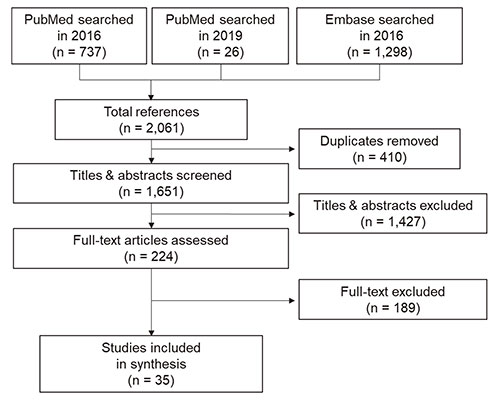 |
| Fig. 1 Flow diagram of included studies |
宇宙航空環境医学 Vol. 56, No. 2, 11-24, 2019
Review
Biomarkers for detecting psychological stress of simulated spaceflight mission in a confined environment:a structured review
Shotaro Doki1, Daisuke Hori1, Shin-Ichiro Sasahara1,*, Yasuhito Hirai1,2, Yuichi Oi1, Yuh Ohtaki3, Andrea Christina-Sylvia3, Kunitoshi Hishikawa4,5, Olga Malyshevskaya6, Rintaro Mori7, Ichiyo Matsuzaki1,6
1Faculty of Medicine, University of Tsukuba
2Hirai Yasuhito Occupational Health Physician’s Office
3Graduate School of Comprehensive Human Sciences, University of Tsukuba
4Faculty of Humanities and Social Sciences, University of Tsukuba
5International Center, Kindai University
6International Institute for Integrative Sleep Medicine, University of Tsukuba
7National Center for Child Health and Development
*Corresponding author
ABSTRACT
Appropriate stress monitoring in crews performing long-term missions in space is necessary for optimal performance and safety. No method has been established for accurate stress detection, thus making such research necessary. Among the several sources of stress experienced by astronauts, we focused on the stress in a confined environment and performed a structured review to identify related biomarkers. Two different databases PubMed and EMBASE were searched to determine the kind of biomarkers useful for detecting stress in a confined environment. The inclusion criteria were:simulation studies of the International Space Station (ISS), the Mir space station, and space flights, and studies that surveyed blood, salivary, and urinary samples as biomarkers for detecting stress. The Mars 500, the Mars 105, and the ASESSII studies suggested that cortisol levels increased during confinement, however, in the EXEMSI and the ISEMSI, cortisol levels remained unaltered throughout the confinement period. The results indicated that cortisol levels underwent changes in the mid- and the long-term confinement studies, but there were no consistent opinions on other biomarkers such as the thyroid and the steroid hormones, amylase, blood cell counts, and BDNF, as well as cardiovascular- and immune-related biomarkers and glycometabolism-related biomarkers. Further investigation will therefore, be necessary to determine whether any biomarkers other than cortisol may be useful for stress detection.
(Receoved:12 June, 2019 Accepted:28 February, 2020)
Key words:Isolation, psychological stress, systematic review, astronauts, confinement study
I. INTRODUCTION
Manned space development is now progressing towards programs focused on colonizing the moon and Mars. NASA is now planning the construction of a manned base named the Lunar Orbital Platform-Gateway in the lunar orbit, for deep space exploration1).
When taking into consideration the health maintenance and safety of the crews performing long-term missions in space, the related stress levels must be assessed. Stress increases the probability of mistakes and fatal accidents during missions. A relationship between the work-rest schedules and the occurrence of work-related errors by the astronauts has been previously reported2). Sleep may also be affected, and Mallis et al. reported a relationship between sleep deprivation of astronauts and their performance levels3). Work can be more safely performed if stress is assessed before the assignment takes place, so that the work can be adjusted accordingly.
Various stress sources can be considered significant, including microgravity, cosmic rays, and confinement. Experiments on confinement-related stress can be performed on Earth and, to date, have been included in the Isolation Study for European Manned Space Infrastructure (ISEMSI), Experimental Campaign for the European Manned Space Infrastructure (EXEMSI), Simulation of Flight of International Crew on Space Station-99 (SFINCSS-99), the Mars 105, and the Mars 500 simulations, among others4-8). Crew members experience psychological stress derived from interpersonal relations within their crew, long-term confinement, clashes with controllers, and due to a lack of means of eliminating stress.
There is a need for knowledge on methods for detection of these stress modes, but related consensus has been scarce. Methods that may be considered include self-administered questionnaires, including given task loads, and biomarker measurement. Biomarker measurement is desirable because of its reproducibility and objectivity. To date, confinement studies have been performed with cortisol and catecholamine tests and immune reaction tests, among others, but due to the small number of subjects in each study and differences among the experimental systems, the results have been inconsistent and marked by dispersion9). Therefore , it remains unclear which test parameters can appropriately detect confinement stress.
The objective of the present study was to summarize the findings of confinement studies that have reported stress detection by biomarkers as objective indicators by conducting a structured review.
II. MATERIALS AND METHODS
Two different databases─PubMed and EMBASE─were searched to determine the kind of biomarkers that are useful for detecting stress in a confined environment. Search terms were selected using a PECO (Population, Environment, Control, and Outcome) approach. The population consisted of astronauts, cosmonauts, and subjects of confinement studies. In terms of outcomes, studies that surveyed blood, salivary, and urinary samples as biomarkers for detecting stress were included. All studies published until August 3, 2016 in EMBASE and August 12, 2016 in PubMed were searched. In addition, to update the data set, the search was conducted again, comprising studies published from August 13, 2016 to April 15, 2019 in PubMed. We could not use EMBASE because the contract of our institution had expired. Articles written in all languages were selected. The search strategy (PubMed only) has been shown in Appendix A. Review teams of two independent experts assessed the identified articles. First, duplicates from the two databases were excluded. Second, the article titles and abstracts were assessed, and then the full text versions of relevant articles were collected and assessed using the inclusion and exclusion criteria. A consensus between three experts was used to resolve any disagreements between the two reviewers. The inclusion criteria were the simulation studies of the International Space Station (ISS), the Mir space station, and space flights, the studies that surveyed blood, salivary, and urinary samples as biomarkers for detecting stress that obtained at least two data points, such as pre- and post-confinement, and peer-reviewed articles. Exclusion criteria were the space flight missions, animal research, in vitro studies, conference papers, expert opinions, editorials, letters to the editor, and commentaries. In the present study, a confinement study such as a simulation of an isolated environment was the target, therefore, space flight studies were excluded. The review of space flight from this search result will be reported elsewhere.
III. RESULTS
2,061 articles were identified (Fig. 1) on EMBASE and PubMed. A total of 410 duplicate articles were deleted, and conference papers, review articles, editorials, and commentaries were removed. 1,651 titles and abstracts were screened. Full-text articles that matched the inclusion and exclusion criteria were selected. In total, the selection included 35 articles.
 |
| Fig. 1 Flow diagram of included studies |
A. Study projects
There were 12 confinement studies among the selected articles:ASSESS II, EXEMSI, HUBES, ISEMSI, JAMSTEC, MARS105, MARS500, MDRS, NEEMO, New Mexico 131-day confinement study, SFINCSS 99, and the Tsukuba 7-day confinement study. The characteristics of the included studies have been shown in Table 1.
| Table 1 The characteristics of the included studies |
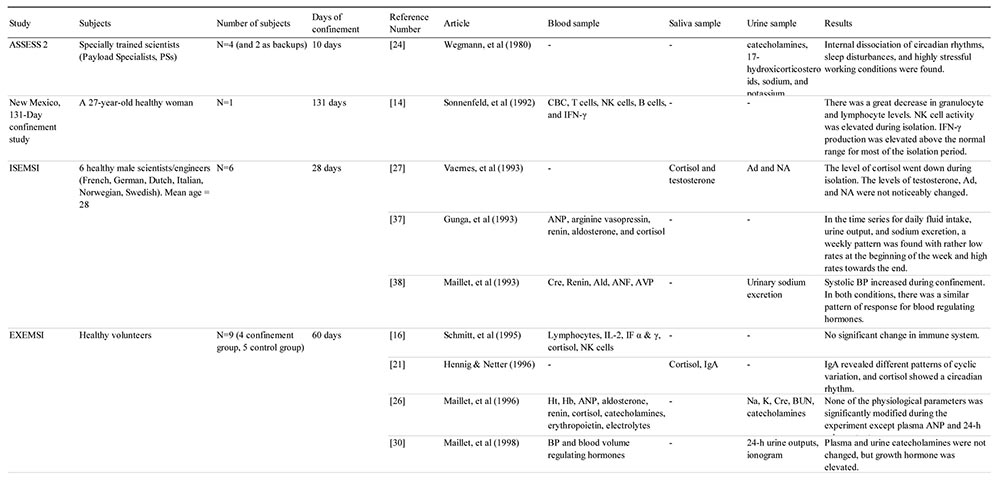 |
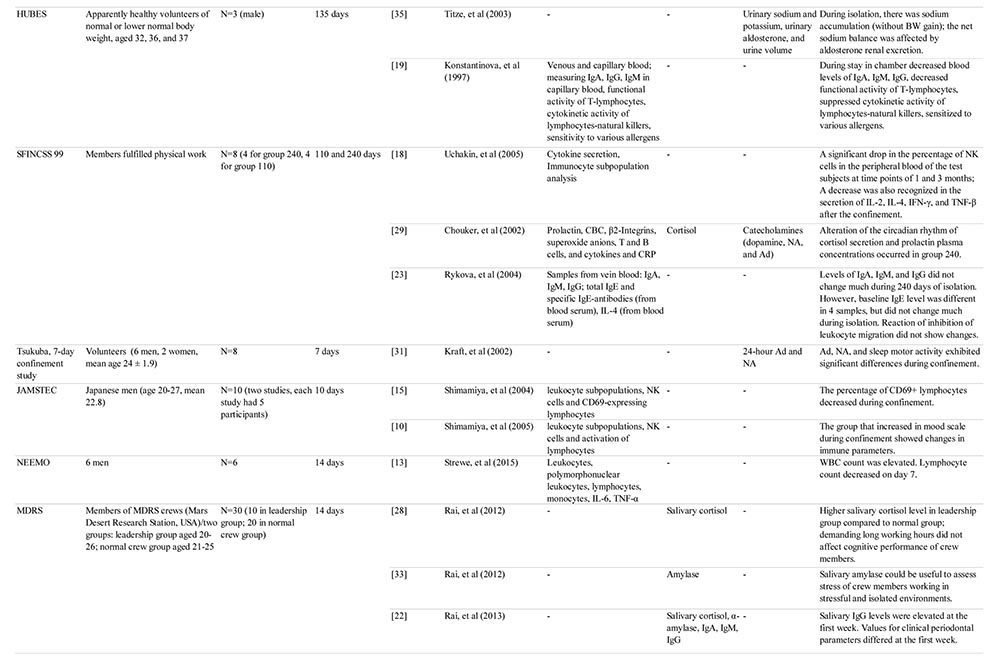 |
 |
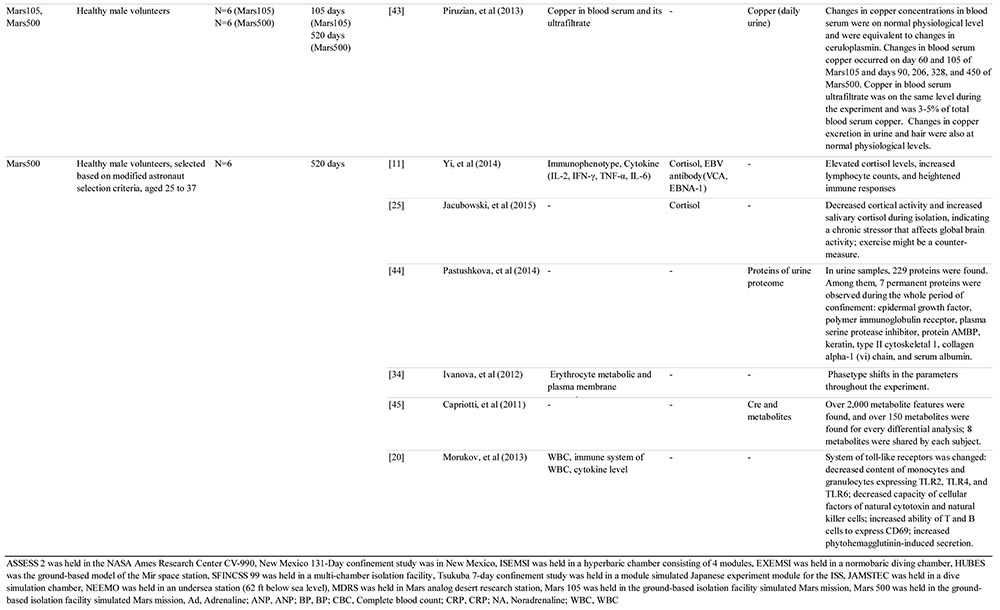 |
B. Study settings
All studies were cohort studies. The subjects were healthy volunteers and specially trained scientists. The number of subjects ranged from 1 to 30, and the period of confinement ranged from 7 days to 520 days.
C. Biomarkers
1. Immune-related biomarkers
A change in the total leukocyte count was not found in JAMSTEC and Mars 10510,11), but counts increased in Mars 500 and NEEMO12,13). Granulocyte counts increased during confinement from the beginning to the end10), but lymphocyte counts decreased in JAMSTEC and New Mexico in 131 days10,14,15). In EXSMSI and Mars 105, lymphocyte counts remained unaltered16,17). However, increased lymphocyte counts were found in Mars 50012). No similar tendencies were found among studies on leukocyte counts and their distribution. In terms of the NK cells, the counts did not change in EXEMSI, Mars 500, and New Mexico in 131 days12,14,16), while a significant decrease in the percentage of the NK cells (CD3−CD16+CD56+) was found at 1 months and 3 months in SFINCSS 9918). The activity of the T cells declined from day 22 of confinement in HUBES19), but both T and B cells showed an increase during confinement in Mars 50012,20). In SFINCSS 99, no change was found in the composition of the T and the B cells and monocytes18). IL-2 and the interferons (IFN)-α and -γ were unchanged in EXEMSI16), while a decrease was also seen in the secretion of IL-2, IL-4, IFN-γ, and TNF-β after confinement in SFINCSS 9918). The levels of IgA in EXEMSI and IgG in MDRS increased in the early stage of confinement21,22), but in HUBES, IgA, IgM, and IgG levels decreased from day 22 and recovered after confinement19). In SFINCSS 99, the levels of IgA, IgM, and IgG did not change during the 240 days of confinement23). In Mars 500, there were no VCA and EBNA antibody changes11).
2. Hypothalamus-pituitary-adrenal axis
Mars 500, Mars 105, and ASESSII studies suggested that cortisol levels increased during confinement7,12,24,25). In EXEMSI and ISEMSI, cortisol levels were unchanged from before confinement to that after confinement26,27). When compared to the normal group, the leadership group presented with higher salivary cortisol levels in MDRS28). The rhythm of cortisol secretion in SFINCSS 99 changed in group 24029). Detailed data have been shown in Table 2.
Confinement in EXEMSI, ISEMSI, and Mars 105 did not yield any changes in the catecholamine levels26,27,30). Catecholamine levels increased considerably in ASSESSII24). Higher nocturnal norepinephrine excretion related to higher motor activity during sleep was seen in the Tsukuba 7-day confinement experiment31).
| Table 2 The detail information of cortisol levels in studies |
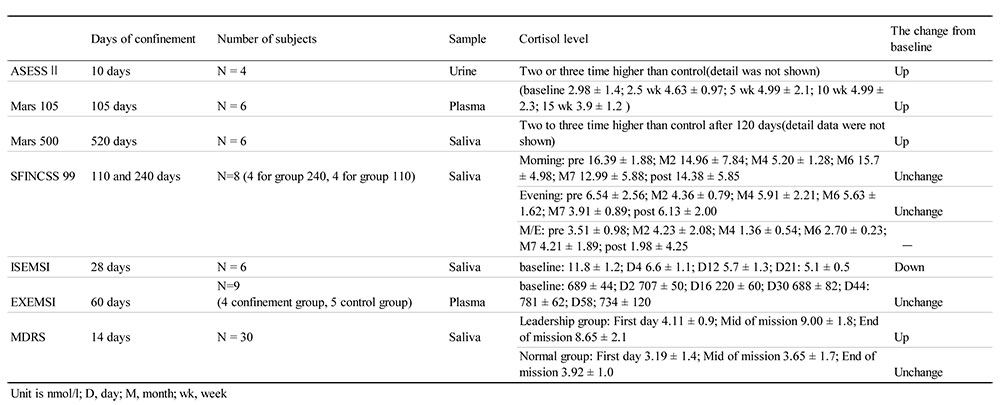 |
3. Sex steroid hormones
Urine free testosterone excretion increased significantly in Mars 10532).
4. Amylase
In MDRS, at the point of pre-extravehicular activity, an increase in the salivary amylase was found. Furthermore, a correlation between amylase and anxiety was also found33).
5. Blood cell counts
Hemoglobin content in blood and erythrocytes increased only on day 510 of confinement and during the recovery period in Mars 50034).
6. Cardiovascular system
Sodium accumulation and body weight gain were observed in HUBES35), but in the case of Mars 105, sodium consumption was reduced36). There was a weekly pattern of fluid and sodium excretion37). Atrial natriuretic peptide (ANP) was elevated during confinement in EXEMSI26), and systolic blood pressure (SBP) was elevated during confinement in the ISEMSI38).
7. Glycometabolism
In the early period, insulin sensitivity increased and then returned to that of the baseline level in Mars 10539,40,41).
8. Thyroid hormone
No thyroid hormonal changes were found in Mars 10539).
9. BDNF
Plasma BDNF levels increased significantly after 5 weeks, and then again after 10 weeks, in Mars 1057).
10. Trace elements
Serum magnesium levels dropped from those at the baseline, but it was within the normal limit in Mars 10542). Serum, urine, and hair copper levels changed within the normal limits in Mars 105 and Mars 50043).
11. Others
In urine samples, 7 permanent proteins were observed during the whole period of confinement over the entire length of the investigation44), and 8 metabolites were shared by each subject in Mars 50045).
IV. DISCUSSION
In the present review, we summarized the findings on biomarkers for stress detection in confinement studies. Many differences were found between studies on changes in the immune system. There has been persistence on the lack of clarity on the parameters that may be effective as biomarkers for stress detection, but it was found that cortisol levels may rise in the long-term confinement studies. Other biomarkers were investigated, but they were not tested in multiple studies, making it difficult to determine their potential for stress detection.
At present, a lack of clarity remains on the substances that may serve as biomarkers for stress detection, but a rise in cortisol levels has been observed during both the mid- and the long-term confinement periods of 105 days and 520 days7,12). In the 110- and 240-day confinement periods in SFINCSS-99, post-confinement evening cortisol rose, and the morning-evening (m/e) cortisol ratio decreased both in the 110-day test subjects, and the 240-day test subjects. In the 4th and 5th months, a rise in evening cortisol was accompanied by a decrease in the morning-evening (m/e) cortisol ratio29). This suggests some degree of validity in using cortisol as a biomarker for stress detection under the mid- to the long-term confinement, in time units of several months.
In prior stress detection studies, it was reported that cortisol values increased in space shuttle crews before launch of the shuttle and during their return, and that cortisol changes were greater in the long-term ISS crew members than those in the short-term Space Shuttle crews46). Data from the long-term Mir spaceflight showed that morning-to-evening cortisol differences decreased, supporting the results of the present study, but the cortisol value was highest before flight, which has been hypothesized to be an effect of a pre-flight training47). In an actual spaceflight, training received before entering confinement and the pre-launch stress had an influence on the cortisol levels, thus showing that factors other than confinement must also be considered. Immune functions were also measured. It has been suggested that changes in the toll-like receptors, the NK cells, and the T and B cells may have an effect on the immune system48) but, in the present review, their changes were found to differ from the study, and no consistent opinion was obtained. This may mean that immune functions are more strongly affected by microgravity and cosmic rays than by confinement. The relationship between depression and low BDNF blood levels has been noted in previous studies49,50), but in the present review, BDNF was found to have increased in Mars 105, and its usefulness as a biomarker remains unclear. Substances such as amylase and ANP have been investigated in confinement studies, but the number of tests was small, and generalization was difficult.
One strength in this study can be highlighted by the exclusion of the effects of cosmic rays and microgravity in the search for biomarkers for stress detection in confinement. Moreover, although the titles and abstracts were in English, texts in many different languages were explored, therefore resulting in an extensive coverage. This study showed the possibility of using cortisol as a biomarker for stress detection in mid- to long-term confinement in time units of several months, and has provided findings that will be useful for subsequent confinement studies. The results also showed, however, that further testing on biomarkers other than cortisol will be necessary because of the small number of studies involved and the absence of consistent opinions regarding them.
One limitation of the present study was the difference between the studies reviewed in the tasks performed during confinement. Therefore, it is possible that the different stress types applied to the subjects were not consistent, thus leading to different results, even when the same biomarker was investigated. Another limitation was that statistical analysis could not be performed due to the small number of subjects. Also, without a randomized control, the effect of the confinement could not be compared with a control.
V. CONCLUSIONS
The findings on biomarkers for stress detection in confinement studies have been summarized by a structured review that showed that cortisol levels change in the mid- and the long-term confinement studies, but there was no consistent opinion on other biomarkers. Further investigation will, therefore, be necessary to determine whether any biomarker other than cortisol may be useful for stress detection.
VI. ACKNOWLEDGMENTS
The authors thank Ms. Ignatochkina Anna, Ms. Yukiko Maeda, Ms. Miwako Segawa, Ms. Chiemi Kataoka, and Ms. Yuko Serizawa for their generous cooperation. This work was supported by the JSPS KAKENHI Grant Number JP15H05941. The authors declare that they have no conflicts of interest.
REFERENCES
| 1) | NASA, Deep Space Gateway to Open Opportunities for Distant Destinations. https://www.nasa.gov/feature/deep-space-gateway-to-open-opportunities-for-distant-destinations (accessed 7 September 2018). |
| 2) | Nechaev, A.P.:Work and rest planning as a way of crew member error management. Acta Astronaut., 49, 271-278, 2001. |
| 3) | Mallis, M.M. and DeRoshia, C.W.:Circadian rhythms, sleep, and performance in space. Aviat. Space Environ. Med., 76, B94-107, 2005. |
| 4) | Sandal, G.M.:Psychosocial issues in space:future challenges. Gravit. Space Biol. Bull., 14, 47-54, 2001. |
| 5) | Gushin, V.I., Pustynnikova, J.M. and Smirnova, T.M.: Interrelations between the small isolated groups with homogeneous and heterogeneous composition. Hum. Perf. Extrem. Environ, 6, 26-33, 2001. |
| 6) | Inoue, N., Matsuzaki, I. and Ohshima, H.:Group interactions in SFINCSS-99:lessons for improving behavioral support programs. Aviat. Space Environ. Med., 75, C28-35, 2004. |
| 7) | Strollo, F., Vassilieva, G., Ruscica, M., Masini, M., Santucci, D., Borgia, L., Magni, P., Celotti, F. and Nikiporuc, I.:Changes in stress hormones and metabolism during a 105-day simulated Mars mission. Aviat. Space Environ. Med., 85, 793-797, 2014. |
| 8) | Schneider, S., Brümmer, V., Carnahan, H., Kleinert, J., Piacentini, M.F., Meeusen, R. and Strüder, H.K.:Exercise as a countermeasure to psycho-physiological deconditioning during long-term confinement. Behav. Brain Res., 211, 208-214, 2010. |
| 9) | Pagel, J.I. and Choukèr, A.:Effects of isolation and confinement on humans-implications for manned space explorations. J. Appl. Physiol., 120, 1449-1457, 2016. |
| 10) | Shimamiya, T., Terada, N., Wakabayashi, S. and Mohri, M.:Mood change and immune status of human subjects in a 10-day confinement study. Aviat. Space Environ. Med., 76, 481-485, 2005. |
| 11) | Strewe, C., Muckenthaler, F., Feuerecker, M., Yi, B., Rykova, M., Kaufmann, I., Nichiporuk, I., Vassilieva, G., Hörl, M., Matzel, S., Schelling, G., Thiel, M., Morukov, B. and Choukèr, A.:Functional changes in neutrophils and psychoneuroendocrine responses during 105 days of confinement. J. Appl. Physiol., 118, 1122-1127, 2015. |
| 12) | Yi, B., Rykova, M., Feuerecker, M., Jäger, B., Ladinig, C., Basner, M., Hörl, M., Matzel, S., Kaufmann, I., Strewe, C., Nichiporuk, I., Vassilieva, G., Rinas, K., Baatout, S., Schelling, G., Thiel, M., Dinges, D.F., Morukov, B. and Choukèr, A.:520-d Isolation and confinement simulating a flight to Mars reveals heightened immune responses and alterations of leukocyte phenotype. Brain Behav. Immun., 40, 203-210, 2014. |
| 13) | Strewe, C., Crucian, B.E., Sams, C.F., Feuerecker, B., Stowe, R.P., Choukèr, A. and Feuerecker, M.:Hyperbaric hyperoxia alters innate immune functional properties during NASA Extreme Environment Mission Operation (NEEMO). Brain Behav. Immun., 50, 52-57, 2015. |
| 14) | Sonnenfeld, G., Measel, J., Loken, M.R., Degioanni, J., Follini, S., Galvagno, A. and Montalbini, M.:Effects of isolation on interferon production and hematological and immunological parameters. J. Interferon Res., 12, 75-81, 1992. |
| 15) | Shimamiya, T., Terada, N., Hiejima, Y., Wakabayashi, S., Kasai, H. and Mohri, M.:Effects of 10-day confinement on the immune system and psychological aspects in humans. J. Appl. Physiol., 97, 920-924, 2004. |
| 16) | Schmitt, D.A., Peres, C., Sonnenfeld, G., Tkackzuk, J., Arquier, M., Mauco, G. and Ohayon, E.:Immune responses in humans after 60 days of confinement. Brain Behav. Immun., 9, 70-77, 1995. |
| 17) | Strewe, C., Muckenthaler, F., Feuerecker, M., Yi, B., Rykova, M., Kaufmann, I., Nichiporuk, I., Vassilieva, G., Hörl, M., Matzel, S., Schelling, G., Thiel, M., Morukov, B. and Choukèr, A.:Functional changes in neutrophils and psychoneuroendocrine responses during 105 days of confinement. J. Appl. Physiol., 118, 1122-1127, 2015. |
| 18) | Uchakin, P.N., Uchakina, O.N., Morukov, B.V., Larina, I.M., Bogdanova, N.B., Mezentseva, m.V., Tobin, B.V. and Ershov, F.I.:The endogenous regulation of the cytokine disbalance in humans subjected to simulated spaceflight environment. Vestn. Ross. Akad. Med. Nauk., 7, 15-20, 2006. |
| 19) | Konstantinova, I.V., Antropova, E.N., Meshkov, D.O., Rykova, M.P. and Lesniak, A.T.:Immune resistance of humans during extended isolation. Aviakosm. Ekolog. Med., 31, 57-60, 1997. |
| 20) | Morukov, B.V., Rykova, M.P., Antropova, E.N., Berendeeva, T,A., Morukov, I.B. and Ponomarev, S.A.:Immunological aspects of a piloted mission to Mars. Fiziol. Cheloveka., 39, 19-30, 2013. |
| 21) | Hennig, J. and Netter, P.:Local immunocompetence and salivary cortisol in confinement. Adv. Space Biol. Med., 5, 115-132, 1996. |
| 22) | Rai, B. and Kaur, J.:Periodontal status, salivary immunoglobulin, and microbial counts after short exposure to an isolated environment. J. Oral Sci., 55, 139-143, 2013. |
| 23) | Rykova, M.P., Gertsik, Yu.G., Antropova, E.N., Buravkova, L.B. and Meshkov, D.O.:Outcome of the long-term isolation on the development of allergic reactions in humans. Aviakosm. Ekolog. Med., 38, 24-28, 2004. |
| 24) | Wegmann, H.M., Herrmann, R. and Winget, C.M.: Bioinstrumentation for evaluation of workload in payload specialists:results of ASSESS II. Acta Astronaut., 7, 1307-1321, 1980. |
| 25) | Jacubowski, A., Abeln, V., Vogt, T., Yi, B., Choukèr, A., Fomina, E., Strüder, H.K. and Schneider, S.:The impact of long-term confinement and exercise on central and peripheral stress markers. Physiology and Behavior., 152, 106-111, 2015. |
| 26) | Maillet, A., Normand, S., Gunga, H.C., Allevard, A.M., Cottet-Emard, J.M., Kihm, E., Strollo, F., Pachiaudi, C., Kirsch, K.A., Bizollon, C.A., Gauquelin, G. and Gharib, C.:Hormonal, water balance, and electrolyte changes during sixty-day confinement. Adv. Space Biol. Med., 5, 55-78, 1996. |
| 27) | Vaernes, R.J., Bergan, T., Warncke, M., Ursin, H., Aakvaag, A. and Hockey, R.:European isolation and confinement study. Workload and stress:effects on psychosomatic and psychobiological reaction patterns. Adv. Space Biol. Med., 3, 95-120, 1993. |
| 28) | Rai, B., Foing, B.H. and Kaur, J.:Working hours, sleep, salivary cortisol, fatigue and neuro-behavior during Mars analog mission:five crews study. Neurosci. Lett., 516, 177-181, 2012. |
| 29) | Choukèr, A., Smith, L., Christ, F., Larina, I., Nichiporuk, I., Baranov, V., Bobrovnik, E., Pastushkova, L., Messmer, K., Peter, K. and Thiel, M.:Effects of confinement (110 and 240 days) on neuroendocrine stress response and changes of immune cells in men. J. Appl. Physiol., 92, 1619-1627, 1985. |
| 30) | Maillet, A., Gunga, H.C., Normand, S., Allevard, A.M., Cottet-Emard, J.M., Pachiaudi, C., Kirsch, K.A., Gharib, C. and Gauquelin-Koch G.:Effects of a 60-day confinement on the blood pressure, hormonal responses and body fluids of a mixed crew. J. Gravit. Physiol., 5, 55-64, 1998. |
| 31) | Kraft, N.O., Inoue, N., Mizuno, K., Ohshima, H., Murai, T. and Sekiguchi, C.:Physiological changes, sleep, and morning mood in an isolated environment. Aviat. Space Environ. Med., 73, 1089-1093, 2002. |
| 32) | Larina, I.M., Kochnova, E.A., Pastushkova, L.Kh., Rodchenkov, G.M., Nosovskiǐ, A.M. and Nikolaev, E.N.:Profile of sex steroids in healthy volunteers’ urine during experiment in isolated object. Fiziol. Cheloveka., 37, 79-89, 2011. |
| 33) | Rai, B., Kaur, J. and Foing, B.H.:Salivary amylase and stress during stressful environment:three Mars analog mission crews study. Neurosci. Lett., 518, 23-26, 2012. |
| 34) | Ivanova, S.M., Mokurov, B.V., Iarlykova, Iu.V. and Labetskaia, O.I.:Studies of red blood cells biochemistry and erythropoiesis intensity in humans during the 520-day isolation study. Aviakosm. Ekolog. Med., 46, 19-23, 2012. |
| 35) | Titze, J., Larina, I.M., Garib, K., Kirsch, K.O., Maye, A., Lang, R., Gunga, H.K., Johanes, B., Gochlen-Koch, H. and Kim, E.:Studies of sodium balance in human during long-term isolation in ground-based space station model. Fiziol. Cheloveka., 29, 90-101, 2003. |
| 36) | Binder, H., Wirth, H., Arakelyan, A., Lembcke, K., Tiys, E.S., Ivanisenko, V.A., Kolchanov, N.A., Kononikhin, A., Popov, I., Nikolaev, E.N., Pastushkova, L. and Larina, I.M.:Time-course human urine proteomics in space-flight simulation experiments. BMC Genomics, 15, S2, 2014. |
| 37) | Gunga, H.C., Maillet, A., Kirsch, K., Röcker, L., Gharib, C. and Vaernes, R.:European isolation and confinement study. Water and salt turnover. Adv. Space Biol. Med., 3, 185-200, 1993. |
| 38) | Maillet, A., Gauquelin, G., Gunga, H.C., Collet, J., Cottet-Emard, J.M., Allevard, A.M., Fortrat, J.O., Cartier, R., Claustrat, B. and Bizollon, C.A.:European isolation and confinement study. Blood pressure, volume-regulating hormones, and electrolytes. Adv. Space Biol. Med., 3, 201-219, 1993. |
| 39) | Nichiporuk, I.A., Vasil’eva, G.Iu., Noskov, V.B. and Morukov, B.V.:Dynamics of the body composition, neurohumoral and psychophysiological status of humans in the conditions of 105-day isolation and confinement. Aviakosm. Ekolog. Med., 45, 39-44, 2011. |
| 40) | Legen’kov, V.I., Balakhovskiǐ, I.S., Beregovkin, A.V., Moshkalo, Z.S. and Sorokina, G.V.:Changes in peripheral blood composition during 18- and 24-day cosmic flights. Kosm. Biol. Med., 7, 39-45, 1973. |
| 41) | Nichiporuk, I.A., Vasil’eva G.Iu., Rykova, M.P. and Morukov, B.V.:Dynamics of blood concentration of neurospecific proteins and risk of neuropathy development in the conditions of 105-day confinement. Aviakosm. Ekolog. Med., 45, 24-29, 2011. |
| 42) | Piruzian, L.A., Protasova, O.V., Maksimova, I.A., Morukov, B.V., Protasov, S.V. and Ushakov, I.B.:Magnesium level in human organism during 105-day isolation. Aviakosm. Ekolog. Med., 46, 28-31, 2012. |
| 43) | Piruzian, L.A., Protasova, O.V., Maksimova, I.A., Morukov, B.V., Protasov, S.V. and Ushakov, I.B.:Investigation of the copper content in blood serum and its ultrafiltrate in the conditions of experimental space flight simulation. Aviakosm. Ekolog. Med., 47, 48-53, 2013. |
| 44) | Pastushkova, L.Kh., Kireev, K.S., Kononikhin, A.S., Tiys, E.S., Popov, I.A., Dobrokhotov, I.V., Custaud, M.A., Ivanisenko, V.A., Kolchanov, N.A., Nikolaev, E.N., Pochuev, V.I. and Larina, I.M.:Permanent proteins in healthy human’s urine in the experiment with 520-day isolation. Aviakosm. Ekolog. Med., 48, 48-54, 2014. |
| 45) | Capriotti, A.L., Caruso, G., Cavaliere, C, Foglia, P., Bizzarri, M. and Laganà, A.:Rapid resolution liquid chromatography/high resolution tandem mass spectrometry to characterize metabolic changes in subjects involved in MARS500 project. Chromatographia, 73, S45-S53, 2011. |
| 46) | Stowe, R.P., Sams, C.F. and Pierson, D.L.:Adrenocortical and immune responses following short- and long-duration spaceflight. Aviat. Space Environ. Med., 82, 627-634, 2011. |
| 47) | Larina, I.M., Whitson, P., Smirnova, T.M. and Chen, Y.M.: Circadian rhythms of salivary cortisol level during long-term space flight. Fiziol. Cheloveka., 26, 94-100, 2000. |
| 48) | Rykova, M.P.:Immune system in Russian cosmonauts after orbital space flights. Fiziol. Cheloveka., 39, 126-136, 2013. |
| 49) | Bocchio-Chiavetto, L., Bagnardi, V., Zanardini, R., Molteni, R., Nielsen, M.G., Placentino, A., Giovannini, C., Rillosi, L., Ventriglia, M., Riva, M.A. and Gennarelli, M.:Serum and plasma BDNF levels in major depression:a replication study and meta-analyses. World J. Biol. Psychiatry, 11, 763-773, 2010. |
| 50) | Dreimüller, N., Schlicht, K.F., Wagner, S., Peetz, D., Borysenko, L., Hiemke, C., Lieb, K. and Tadić, A.:Early reactions of brain-derived neurotrophic factor in plasma(pBDNF)and outcome to acute antidepressant treatment in patients with Major Depression. Neuropharmacology, 62, 264-269, 2012. |
| Appendix A |
| PubMed: August 12, 2016 and April 15, 2019 |
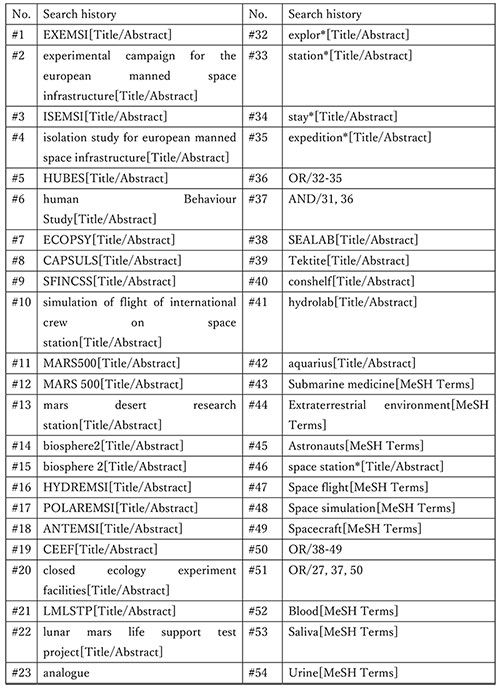 |
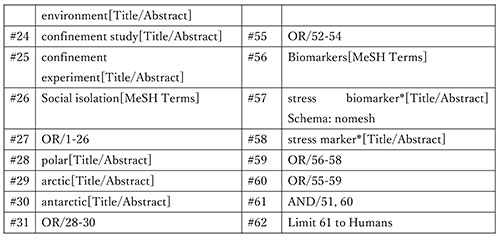 |